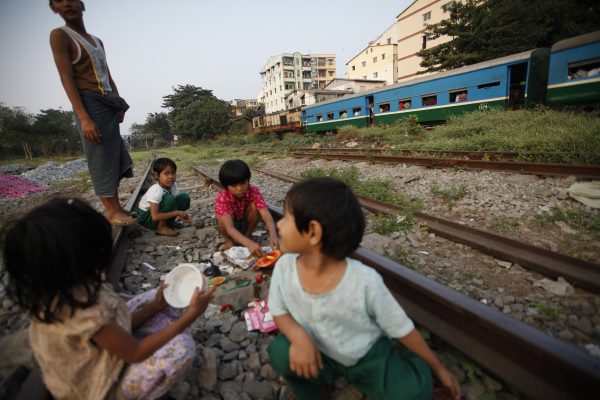The country’s administration and economy have been paralysed since February 2021 when the military junta seized power from the civilian government. The junta stated that widespread electoral fraud in the November 2020 general election justified the coup, although election observers found the election was free and fair. The pro-democracy party, National League for Democracy (NLD), won more than 80 percent of elected seats in the national level bicameral parliament and subnational parliaments.
Myanmar had already experienced institutionalised corruption, multiple ethnic armed conflicts, poverty, an unstable regulatory environment, mismanagement of extractive industries and human rights abuses under the military dictatorship for 50 years before 2011. Since 2011, the country’s economy and living standards improved through a range of political, economic and social reforms under the quasi-civilian and civilian governments. Myanmar experience an average growth rate of 6.6 per cent. People living under the national poverty line declined from 48.2 per cent in 2005 to 24.8 per cent in 2017.
Still, the former NLD government struggled to combat COVID-19. Myanmar was one of the least prepared countries globally, having only 0.7 physicians per 1000 people in 2019. The government launched its COVID-19 Economic Relief Plan (CERP) in April 2020 that included food distribution, cash assistance and free electricity to vulnerable households and households in Internally Displaced Persons (IDPs) camps, soft loans for small businesses, unemployment compensation and a loan scheme for civil servants. By the end of 2020, the government had disbursed more than half of CERP funds, totalling 1.7 per cent of GDP.
The government also announced the Myanmar Economic Recovery and Reform Plan that focussed on long-term macroeconomic and financial stability and sustainable growth which prioritised healthcare spending, tax relief measures and transfers to vulnerable households. The country’s economy suffered in 2020 with an estimated growth rate of 1.7 per cent, down from 6.8 percent in 2019.
Myanmar was one of the first countries in Southeast Asia to receive vaccines in January 2021. The medical response to COVID-19 collapsed after the military coup on 1 February 2021 that led to protests and the Civil Disobedience Movement joined by many healthcare workers.
On 1 August, the junta re-established the State Administrative Council’s management committee as caretaker government led by Prime Minister Min Aung Hlaing and announced that an election would not be held until 2023. This followed the arrests of former Myanmar president Win Myint, state counsellor Aung San Suu Kyi, union ministers, chief ministers and parliamentary members. As a result of the military coup, the economy has been severely damaged by mismanagement.
Several foreign businesses and investors have indicated that they intended to withdraw from Myanmar. Within three months of the coup, foreign investors suspended projects worth US$6 billion. The International Labour Organization estimated that 1.2 million people lost their jobs after the coup.
The rapid depreciation of Myanmar’s kyat against major currencies such as the US dollar has also severely affected consumers and businesses, as most consumer goods such as fuel, edible oil and medicines are imported.
The cost of a basic food basket was 29 per cent higher in October 2021 than January 2021. Severe food insecurity has become a major concern especially among IDPs. In December 2021, internal displacements numbered about 300,000 persons due to armed clashes. More than 11,000 have been arrested and 1400 are reported to have been killed by the military junta.
In 2022, the United Nations estimated that half the population of Myanmar could sink into poverty, with about 14.4 million people needing humanitarian assistance due to the impact of the pandemic and military coup. Most people who need humanitarian assistance are in Yangon (17 per cent) and Mandalay (16 per cent). Humanitarian aid access is extremely challenging for people in Myanmar’s northwest and southeast, where conflicts between the junta troops and anti-military forces are increasing.
On the political front, while the junta’s caretaker government is trying to gain legitimacy from the international community, Canada, the United States, the United Kingdom and the European Union have imposed fresh sanctions on the regime. The junta’s Ministry of Investment and Foreign Economic Relations issued a statement that Myanmar will start accepting the renminbi as an official settlement currency for border trade and to accelerate bilateral cooperation with China.
The International Monetary Fund revised down its forecast for Myanmar’s economic growth rate to negative 0.1 per cent in 2022. Unresolved armed conflict between the military and ethnic armed forces and the increasingly violent military operations and civilian massacres could forbode civil war.
Without restoring political and social stability, as well as normal economic and financial relations with the rest of the world, it appears unlikely that Myanmar can quickly recover from economic and political turmoil.
Soe Nandar Linn is an independent consultant working with the World Bank and other developmental organisations in Myanmar. The views expressed here are solely those of the author.
This article is part of an EAF special feature series on 2021 in review and the year ahead.

